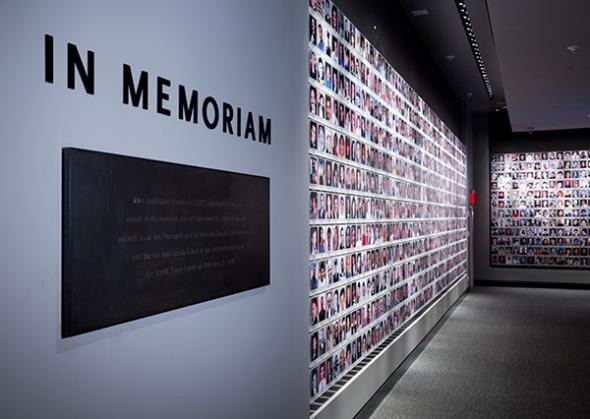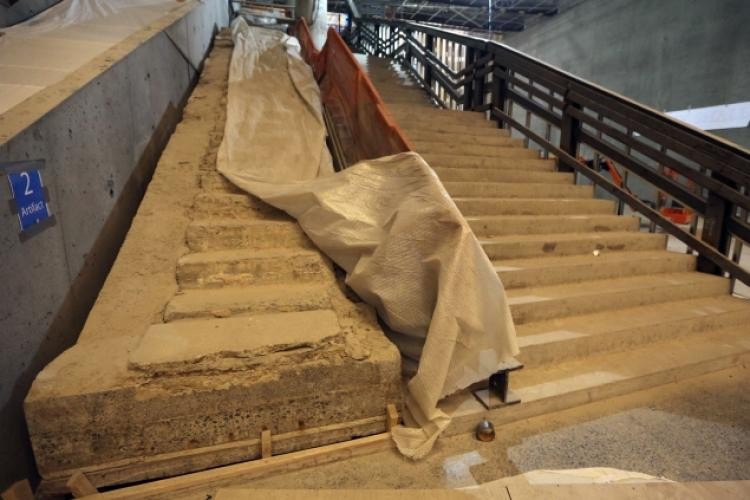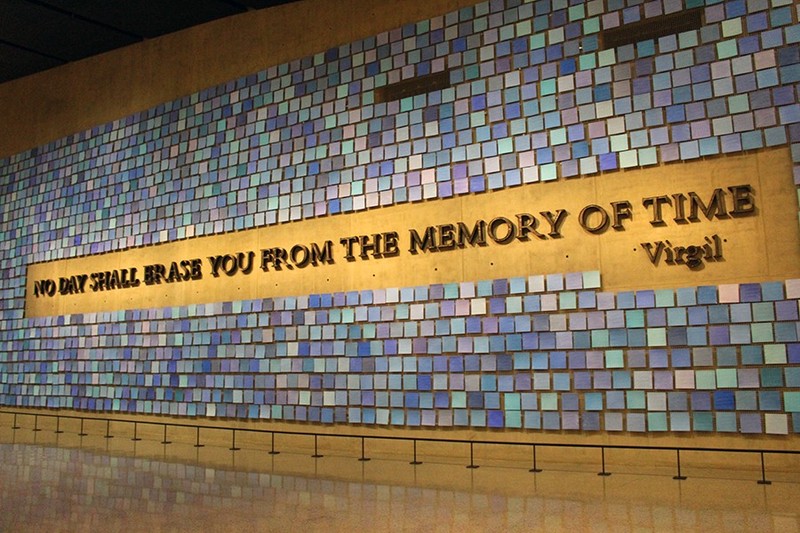The National September 11 Memorial Museum
Introduction
Text-to-speech Audio
On September 11, 2001, the deadliest terrorist attack in history occurred in New York City, when two commercial airplanes, American Airlines 111 and United 175, were hijacked by the al-Quaeda terrorist group. The hijackers crashed these planes into the North and South towers of the World Trade Center, respectively. That day, 2606 people died in and around the location of the World Trade Center. The desire to memorialize the events of September 11th was immediate, and a competition was held for the construction of the World Trade Center Memorial.This museum memorializes the attacks on the World Trade Center in 1993 and 2001 and contains artifacts from Ground Zero, including the "Survivor's Staircase", photographs of the victims, interactive displays, and two main exhibitions. The mission of the museum is to explore the implications and "continuing significance" of the 9/11 attacks. The collection also includes an online catalog and oral histories from first responders and family members of victims.
Images
The Memorial Exhibition--pictures of the victims from the 1993 and 2001 attacks.

"The Survivors Staircase" artifact

"Trying to Remember the Color of the Sky on That September Morning" by Spencer Finch.

Backstory and Context
Text-to-speech Audio
This museum is located within the boundaries of where the World Trade Center once stood and is largely below ground. Visitors enter at the Pavilion, which contains two features: Two tridents, 80 feet tall, that once supported the exterior of the North Tower and a long row of international flags, a collection of which adorned the lobbies of the original WTC, these hang in the atrium1. From the Pavilion, visitors walk down the ramp portion of the museum, which pays tribute to the use of ramps for the construction of the WTC in the 1960s and the Ground Zero Recovery effort, when people and objects needed to be transported away from the site. The "We Remember" audio exhibition can be heard when traveling down the ramps, an oral history of the global significance of 9/11--personal testimonials of the events of 9/11/01. According to the museum's information about this exhibit, it is "recorded in 28 languages spoken by people from 48 different countries"2. Tributes and visual remembrances of the terrorist attacks hang on a 50 ft by 20 ft concrete "Tribute" wall that is located within the "footprint" of the South Tower3. Foundation Hall contains the retaining wall of the WTC that prevailed in the devastation, called "The Slurry Wall," which stands at a height of 36 feet and is plastered in missing persons' posters, inscriptions, and mementos of the victims4. Finally, The Memorial Hall occupies the space between the location of the North and South Tower footprints, and features the watercolor mural "Trying to Remember the Color of the Sky on That September Morning" by Spencer Finch.. The number of tiles that display various shades of blue reflect the number of lives lost in both WTC attacks: 2,983. A quotation from Virgil's Aeneid gives a poignant reminder with the mural, "No Day Shall Erase You From the Memory of Time5."
The museum boasts over 11,000 artifacts, which include remnants of the WTC, personal belongings of the victims, tribute artwork, oral histories, and archives6. These are in a variety of mediums from written work, tangible objects, artwork, and textiles. In addition, more than 40,000 still photographs, 300 moving images, and 3,000 audio recordings and oral histories are housed in the museum's digital collections6. Many of these artifacts are presented in the museum's permanent and rotating exhibitions. "Witness at Ground Zero" is a collection of 500 images of Ground Zero and the events of September 11th photographed by rescuers and other workers, and French photographer, Stephane Sednaoui7. The Historical Exhibition, which is situated in the footprint of the Northern Tower, spans the timeline from pre-9/11, to the attacks themselves, to post 9/11. This exhibition gives context to the 9/11 attacks in the first installment; provides interactive displays that explore the events that took place as well as documenting the actions of first responders in the second installment; and in the third installment, explores the impact that 9/11 left on people from all over the globe8. Another exhibition that allows for reflection is the Memorial Exhibition, which features the photographs and biographies of the victims of both the 1993 and 2001 attacks. Personal items are displayed on a rotating basis, so as to allow the families of the victims to donate items at their discretion9. In addition, there are several exhibitions that include even more photography, interactive displays, and memorabilia. They are Rebirth at Ground Zero, Hope at Ground Zero, Past: Beyond Ground Zero, and Reflecting on 9/11--an opportunity for visitors to record their thoughts about the horrific day and its aftermath. In addition, there are also rotating exhibitions.
The admission fee to the museum varies depending on the choice of general admission or guided tour with a docent, age and membership status. The museum wants to ensure that all visitors have a good experience, and so the museum is entirely accessible to people with mobility devices or limited mobility. There are also pamphlets in Braille or large print, assistance with displays, and audio tours available for visitors who are visually impaired. In addition, for visitors who are deaf or hard of hearing, the museum offers various accommodations including guided tours with American Sign Language interpreters and close captioning on the interactive displays. These must be requested two weeks in advance of the visit. For more information, please click the link that will take you to the Accessibility page for the Museum.
The museum boasts over 11,000 artifacts, which include remnants of the WTC, personal belongings of the victims, tribute artwork, oral histories, and archives6. These are in a variety of mediums from written work, tangible objects, artwork, and textiles. In addition, more than 40,000 still photographs, 300 moving images, and 3,000 audio recordings and oral histories are housed in the museum's digital collections6. Many of these artifacts are presented in the museum's permanent and rotating exhibitions. "Witness at Ground Zero" is a collection of 500 images of Ground Zero and the events of September 11th photographed by rescuers and other workers, and French photographer, Stephane Sednaoui7. The Historical Exhibition, which is situated in the footprint of the Northern Tower, spans the timeline from pre-9/11, to the attacks themselves, to post 9/11. This exhibition gives context to the 9/11 attacks in the first installment; provides interactive displays that explore the events that took place as well as documenting the actions of first responders in the second installment; and in the third installment, explores the impact that 9/11 left on people from all over the globe8. Another exhibition that allows for reflection is the Memorial Exhibition, which features the photographs and biographies of the victims of both the 1993 and 2001 attacks. Personal items are displayed on a rotating basis, so as to allow the families of the victims to donate items at their discretion9. In addition, there are several exhibitions that include even more photography, interactive displays, and memorabilia. They are Rebirth at Ground Zero, Hope at Ground Zero, Past: Beyond Ground Zero, and Reflecting on 9/11--an opportunity for visitors to record their thoughts about the horrific day and its aftermath. In addition, there are also rotating exhibitions.
The admission fee to the museum varies depending on the choice of general admission or guided tour with a docent, age and membership status. The museum wants to ensure that all visitors have a good experience, and so the museum is entirely accessible to people with mobility devices or limited mobility. There are also pamphlets in Braille or large print, assistance with displays, and audio tours available for visitors who are visually impaired. In addition, for visitors who are deaf or hard of hearing, the museum offers various accommodations including guided tours with American Sign Language interpreters and close captioning on the interactive displays. These must be requested two weeks in advance of the visit. For more information, please click the link that will take you to the Accessibility page for the Museum.
Sources
(Overview)
"About the World Trade Center Memorial Competition." World Trade Center Site Memorial Competition. Lower Manhattan Development Corporation, n.d. Web. 5 Aug. 2016. .
Arad, Michael and Walker, Pete.
"Reflecting Absence." World Trade Center Site Memorial Competition. Lower Manhattan Development Corporation, n.d. Web. 5 Aug. 2016. . Smith, Greg B.
"9/11 memorial and museum will open for families of victims, first responders after anniversary ceremony." New York Daily News 9 Sept. 2014. Web. 5 Aug. 2016.
(Additional Information) "Museum Space: The Pavilion." 9/11 Memorial and Museum. National September 11 Memorial & Museum, n.d. Web. 5 Aug. 2016. .
"Museum Space: The Ramp" 9/11 Memorial and Museum. National September 11 Memorial & Museum, n.d. Web. 5 Aug. 2016. .
"Museum Space: Tribute Walk." 9/11 Memorial and Museum. National September 11 Memorial & Museum, n.d. Web. 5 Aug. 2016.
"Museum Space: Foundation Hall." 9/11 Memorial and Museum. National September 11 Memorial & Museum, n.d. Web. 5 Aug. 2016.
"Museum Space: Memorial Hall." 9/11 Memorial and Museum. National September 11 Memorial & Museum, n.d. Web. 5 Aug. 2016. .
"The Collection." 9/11 Memorial and Museum. National September 11 Memorial & Museum, n.d. Web. 5 Aug. 2016. .
"Witness at Ground Zero." Exhibitions. National September 11 Memorial & Museum, n.d. Web. 5 Aug. 2016. .
"Historical Exhibition." Exhibitions. National September 11 Memorial & Museum, n.d. Web. 5 Aug. 2016. .
"Reflecting Absence." World Trade Center Site Memorial Competition. Lower Manhattan Development Corporation, n.d. Web. 5 Aug. 2016. . Smith, Greg B.
"9/11 memorial and museum will open for families of victims, first responders after anniversary ceremony." New York Daily News 9 Sept. 2014. Web. 5 Aug. 2016.
(Additional Information) "Museum Space: The Pavilion." 9/11 Memorial and Museum. National September 11 Memorial & Museum, n.d. Web. 5 Aug. 2016. .
"Museum Space: The Ramp" 9/11 Memorial and Museum. National September 11 Memorial & Museum, n.d. Web. 5 Aug. 2016. .
"Museum Space: Tribute Walk." 9/11 Memorial and Museum. National September 11 Memorial & Museum, n.d. Web. 5 Aug. 2016.
"Museum Space: Foundation Hall." 9/11 Memorial and Museum. National September 11 Memorial & Museum, n.d. Web. 5 Aug. 2016.
"Museum Space: Memorial Hall." 9/11 Memorial and Museum. National September 11 Memorial & Museum, n.d. Web. 5 Aug. 2016. .
"The Collection." 9/11 Memorial and Museum. National September 11 Memorial & Museum, n.d. Web. 5 Aug. 2016. .
"Witness at Ground Zero." Exhibitions. National September 11 Memorial & Museum, n.d. Web. 5 Aug. 2016. .
"Historical Exhibition." Exhibitions. National September 11 Memorial & Museum, n.d. Web. 5 Aug. 2016. .
